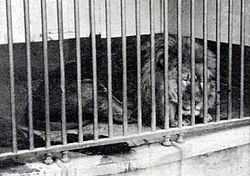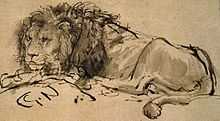Cape lion
| Cape lion | |
|---|---|
 | |
| Only known photo of a live Cape Lion, ca. 1860 in Jardin des Plantes, Paris | |
| Conservation status | |
| Scientific classification | |
| Kingdom: | Animalia |
| Phylum: | Chordata |
| Class: | Mammalia |
| Order: | Carnivora |
| Family: | Felidae |
| Genus: | Panthera |
| Species: | P. leo |
| Subspecies: | †P. l. melanochaitus |
| Trinomial name | |
| Panthera leo melanochaitus Ch. H. Smith, 1858 | |
The Cape lion (Panthera leo melanochaitus) was a subspecies of lion that is now extinct.[1]
Taxonomy

As with the Barbary lion, several people and institutions claim to have Cape lions. There is much confusion between Cape lions and other dark-coloured long-maned captive lions. Dark-maned lions in captivity today have been bred and cross-bred from lions captured in Africa long ago, with examples from all of these 'subspecies'. Mixed together, hybridized, most of today's captive lions have a 'soup' of alleles from many different lion subspecies.[2]
Early authors justified "distinct" subspecific status of the Cape lion because of the seemingly fixed external morphology of the lions. Males had a huge mane extending behind their shoulders and covering the belly, and the lions' ears also had distinctive black tips. However, nowadays it is known that various extrinsic factors, including the ambient temperature, influence the colour and size of a lion's mane.[3] Results of mitochondrial DNA research published in 2006 do not support the "distinctness" of the Cape lion. It may be that the Cape lion was only the southernmost population of the extant Southeast African lion or Transvaal lion.[4]
Description
.jpg)
The Cape lion was the second largest and heaviest of the lion subspecies: a fully grown male could weigh 500 pounds (230 kg) and reach 10 feet (3.0 m) in length.[5] This lion is distinguished by his large size and his thick black mane with a tawny fringe around the face. The tips of the ears were also black.[5]
Behaviour and diet
Cape lions preferred to hunt large ungulates including antelopes, but also zebras, giraffes and buffaloes. They would also kill donkeys and cattle belonging to the European settlers.[6] Man-eating Cape lions were generally old lions with bad teeth, according to Ahuin Haagner in his "South African Mammals".[6]
Habitat
Cape "black-maned" lions ranged along the Cape of Africa on the southern tip of the continent. The Cape lion was not the only subspecies living in South Africa, and its exact range is unclear. Its stronghold was Cape Province, in the area around Cape Town. One of the last Cape lions seen in the province was killed in 1858; in 1876 Czech explorer Emil Holub bought a young lion who died two years later.[7]
Extinction
The Cape lion disappeared so rapidly following contact with Europeans that it is unlikely that habitat destruction was a significant factor. The Dutch and English settlers, hunters, and sportsmen simply hunted it into extinction.
Possible descendants and look-alikes
In 2000, specimens asserted to be descendants of Cape lions were found in captivity in Russia and two of them were brought to South Africa.[8] South African zoo director John Spence reportedly was long fascinated by stories of these grand lions scaling the walls of General van Riebeeck's castle in the 17th century. He studied van Riebeeck's journals to discern Cape lions' features, which include a long black mane, black in their ears, and larger size. He believed some Cape lions might have been taken to Europe and interbred with other lions. His 30-year search led to his discovery of black-maned lions closely resembling Cape lions at the Novosibirsk Zoo in Siberia, in 2000.[9][10] Besides having a black mane, the specimen that attracted Spence had a "wide face and sturdy legs". Novosibirsk Zoo's population, which had 40 cubs over a 30 year period, continues, and Spence was allowed to bring two cubs back to his zoo in South Africa. Back in South Africa, Spence explained that he hoped to breed lions that at least looked like Cape lions, and also hoped to have DNA testing done to establish whether the cubs were descendants.[11] Spence died in 2010 and the zoo closed in 2012, with the lions expected to go to Drakenstein Lion Park.[12]
References
- ↑ Yamaguchi, N. (2000). The Barbary lion and the Cape lion: their phylogenetic places and conservation. African Lion Working Group News 1: 9–11.
- ↑ Maas, P.H.J. 2006. Cape lion – Panthera leo melanochaitus. The Extinction Website. Downloaded on 2 July 2006.
- ↑ West P.M., Packer C. (2002). "Sexual Selection, Temperature, and the Lion's Mane". Science 297 (5585): 1339–43. doi:10.1126/science.1073257. PMID 12193785.
- ↑ Barnett, R., Yamaguchi, N.; Barnes, I. and Cooper, A. (2006). "Lost populations and preserving genetic diversity in the lion Panthera leo: Implications for its ex situ conservation". Conservation Genetics 7 (4): 507. doi:10.1007/s10592-005-9062-0.
- ↑ 5.0 5.1 This Is A Special Lion. Steves Book of the Not-So-Grateful Dead
- ↑ 6.0 6.1 The Extinction Website – Species Info – Cape Lion. Petermaas.nl (2005-11-15). Retrieved on 2012-12-31.
- ↑ The stuffed lion from the Museum of Emil Holub in Holice was, in 2009, identified as Cape lion (there were only six other exemplars preserved worldwide until then). Holub wrote about the lion in his diaries. News about the Holub's lion in Czech language.
- ↑ 'Extinct' lions (Cape lion) surface in Siberia. BBC News (2000-11-05). Retrieved on 2012-12-31.
- ↑ 'Extinct' lions (Cape lion) surface in Siberia. BBC News (2000-11-05). Retrieved on 2012-12-31 and 2015-03-30.
- ↑ "Лев". Sibzoo.narod.ru. Retrieved January 28, 2010.
- ↑ "South Africa: Lion Cubs Thought to Be Cape Lions". AP Archive. 8 November 2000. (with 2-minute video of cubs at zoo with John Spence, 3 sound-bites, and 15 photos)
- ↑ Rebecca Davis (4 June 2012). "We lost a zoo: Western Cape's only zoo closes". Daily Maverick. Retrieved 2015-03-30.
External links
| Wikimedia Commons has media related to Panthera leo melanochaita. |
| Wikispecies has information related to: Panthera leo melanochaita |
